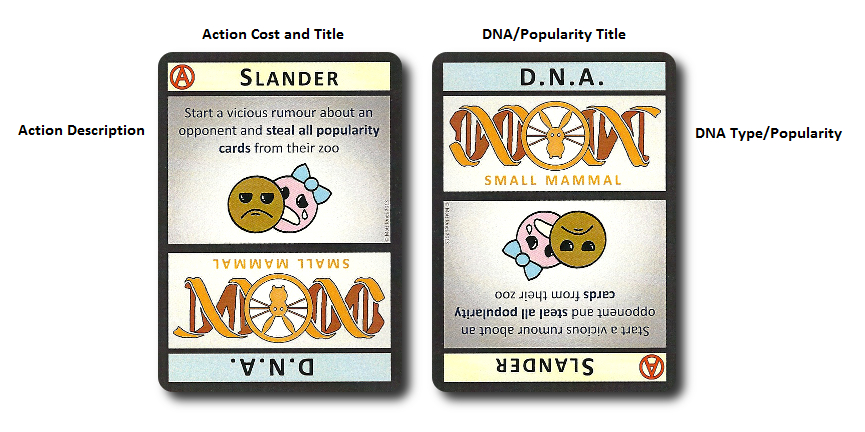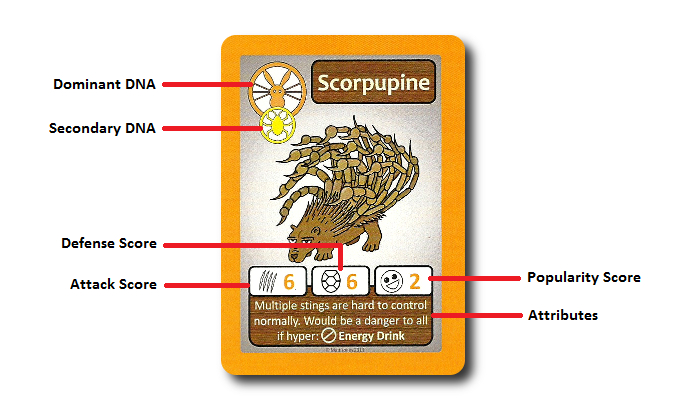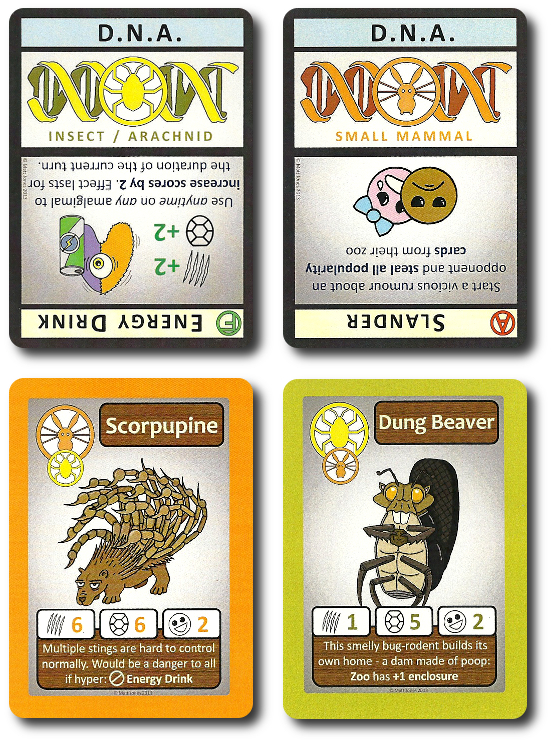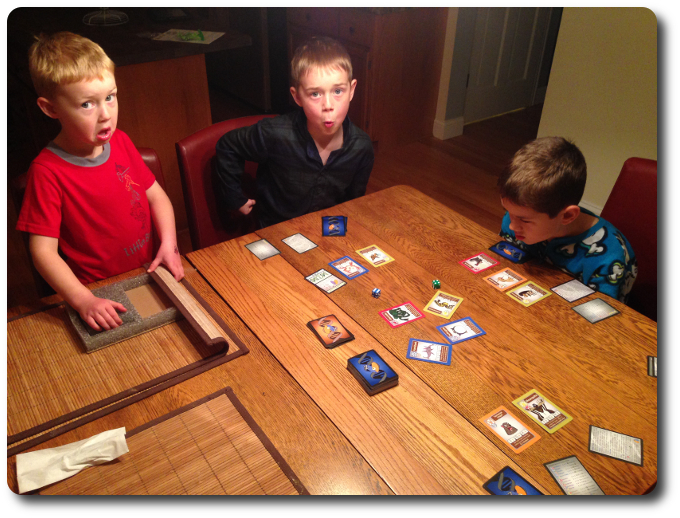
The Basics:
- For ages 7 and up (publishers suggests 8+)
- For 2 to 4 players
- Approximately 20 minutes to complete
Geek Skills:
- Counting & Math
- Logical & Critical Decision Making
- Reading
- Pattern/Color Matching
- Strategy & Tactics
- Risk vs. Reward
- Hand/Resource Management
Learning Curve:
- Child – Easy
- Adult – Easy
Theme & Narrative:
- Create creatures to draw a crowd and to battle!
Endorsements:
- Gamer Geek mixed!
- Parent Geek approved!
- Child Geek approved!
Overview
In order to have a successful zoo, you need to have an attraction everyone wants to see. The problem is, everyone has already seen lions, tigers, and bears. These animals just aren’t drawing the crowds you want, so you turn to science to solve your problems. By splicing the DNA of different animals, you have brought forth creatures that no one has ever seen before! But rivals have been watching and are now doing the same thing for their zoos! It’s a race to see who can create a zoo full of the oddest animals!
Amalgimal Zoo, designed by Matt Jones (II) and self-published via the Game Crafter, is comprised of 30 Amalgimal cards, 70 Lab cards, 4 Amalgimal Quick-List reference cards, 4 Pick Up & Play rule summary cards, and 2 standard six-sided dice. The cards are as durable as your standard playing card and the dice are made of plastic. The artwork by Mr. Jones is excellent, providing a fun visual of the wacky animals that will be genetically engineered.
Preparing the Zoo
To set up the game, first find the Quick-List Reference and Pick Up & Play cards, handing 1 to each player. Players should place these 2 cards in front of them at this time. Any cards not used are returned to the game box.
Second, separate the Lab cards from the Amalgimal cards. Create a deck for each and shuffle.
Third, deal 3 Amalgimal cards face-up to the middle of the playing area. This space is referred to as the “Wild” and represents Amalgimals that are out in the open and available to capture.
Fourth, deal 7 Lab cards to each player, face-down. These cards are the player’s starting hand and available actions.
Sixth, place the Lab and Amalgimal decks face-down near the middle of the playing area. These are the draw decks for the game. Leave room next to each deck for a discard pile.
Seventh, place the dice near the Wild and make sure each player has enough room in front of them to create their zoo.
That’s it for game set up. Let’s make a crazy zoo of awesome animals!
Zoo Ownership and Popularity
Each player owns a zoo at the start of the game. Feel free to give your zoo a name if you like. The name of my zoo was “Papa Cy’s Emporium of the Exquisite ®”. Downright catchy, if you ask me.
Each player’s zoo can hold up to 6 Amalgimals in a row. Note that I use the word “row”. This is important because where each Amalgimal is placed in the row is going to impact game play to some degree. Amalgimals who are directly adjacent to each other (i.e. “side-by-side in the row”) might alter the each other. For example, providing immunity. This is the exception, however, not the rule. Amalgimals come in lots of different shapes and sizes and no two are alike. Players will have to determine how best to house their Amalgimals in hopes of maximizing their benefits.
Once the player has at least 1 Amalgimal in thier zoo, the player’s Popularity score begins to rise. Each Amalgimal has a Popularity score which is added to the player’s total Popularity score. Popularity is one of the two ways a player can win the game.
A player’s zoo is limited to 6 Amalgimals. If the player wants to make room for a new Amalgimal when their zoo is full, they must release one of their Amalgimals into the Wild. The released Amalgimal is placed face-up in the Wild space and the newly acquired Amalgimal is placed in its zoo cage. It’s important for players to actively collect Amalgimal of certain DNA types as this is the second of the two ways a player can win the game.
A Quick Tour of Your Lab
Welcome to your lab! It’s full of the most up-to-date DNA splicing equipment you can imaging. Here you can peel back the mysteries of creation and extract the very essence of what makes animals unique. Then you can mix and match the genetic material to create animals that are both horrific and awe-inspiring. Which is great, because both will bring in the rubes and their money. This isn’t about science; this is about getting rich. Dollar-dollar bill, y’all.
The Lab cards are your ticket to the magical world of animal mutation. Each Lab card has a dual purpose. On one end is a specific DNA strain from an animal type (more on that later). The other end has a special action or bonus that the player can use by discarding the Lab card. These special bonuses and actions differ and range from protecting the player’s zoo to force feeding an energy drink to an Amalgimal. How the Lab cards are used is up to the player, but they can only do one of the following: help create a new Amalgimal or be used on an existing Amalgimal or zoo. Not both. As such, players will need to decide if the Lab card is best saved for its genetic material or its action.

Amalgimals Abound
Amalgimals are not born; they are made. Made, as it turns out, by you. Well, you and the other players who don’t seem to respect the natural law of things. No matter. Where nature has failed to impress, you shall prevail.
In total, there are 6 major types of DNA the players will be using. These 6 DNA types can be combined to form a total of 30 different kinds of Amalgimals. The 6 major types are:
- Large Mammal DNA
- Small Mammal DNA
- Reptile/Amphibian DNA
- Aquatic DNA
- Bird DNA
- Insect/Arachnid DNA
Using 2 of the major DNA types, the player will create unique Amalgimals. The catch is, the DNA can only be mixed and matched a limited number of times. Amalgimals are created using a “Dominant” and “Secondary” DNA. Two Amalgimals that share the same DNA, but are found in alternating Dominant and Secondary positions, are referred to as “DNA counterparts”. Only one of each Dominant and Secondary DNA pairing is found in the game. For example, The “Scorpupine” Amalgimal card is the only Amalgimal that uses Small Mammal DNA as the Dominant and Insect/Arachnid DNA as the Secondary.
Players will also notice that Amalgimal cards come with Attack, Defense, and Popularity scores. The Attack and Defense scores are used in combat, while the Popularity score is one of two different ways to win the game. The Attributes found on the Amalgimal card further define and refine the Amalgimal. For example, the “Scorpupine” Amalgimal card cannot be given a Lab card that provides a bonus via an Energy Drink out of fear that everyone (including the Amalgimal) would be stung to death.

Building an Oddity
Amalgimal Zoo is played in turns with no set number of turns per game. On a player’s turn they will be able to take a total of 3 actions. The first and second actions are selected by the player. These are referred to as “optional actions” and the player can take the same optional action twice or mix and match as needed.. They can also choose to not take any and skip right to the third action. The third action is mandatory and is referred to as “required action”. Each action is summarized here.
Optional Action: Play Lab Cards for Actions
Lab cards, if not used for their genetic material, will provide the player with an action or a bonus. Not all Lab cards cost the player one of their two actions, however. Some Lab cards can be played for free. These Lab cards have a “Free” icon on them. All other Lab cards will have an “Action” icon on them.
Lab cards are often used to add bonuses to a player’s other actions, improving their odds of success, or changing the rules of the game temporarily to give the player a competitive edge. Other Lab cards will allow the player to play Lab cards out of turn and block opponents’ actions. They also provide a variety of nasty ways to mess up an opponent’s game and their zoo.
The majority of Lab cards played are sent to the discard pile once they are resolved. Some Lab cards remain for the turn and some stay in play permanently. For example, the “Construction” Lab card stays in play, permanently attached to the player’s zoo.
Optional Action: Splice DNA
If the player has the right Lab cards, they can select 2 and use the Lab cards for the animal DNA they represent. When the 2 cards are selected, the player must decide which of the two Lab cards represents the dominant DNA. This determines how the Amalgimal is made. The player places the two Lab cards (DNA side up) and declares which of the 2 is dominate. The player then picks up the Amalgimal deck and looks for the creature they have made. Each pairing of DNA has 2 possible outcomes. Let’s take a look at one example.
Using the Insect/Arachnid DNA and the Small Mammal DNA, we currently have two Amalgimals we could create. It all depends on which of the two DNA types we want to set as the Dominate and if the DNA pairing is available. If we set the Insect/Arachnid DNA to Dominate, we could create the “Dung Beaver” Amalgimal. It’s not very strong, but it does give our zoo a bonus. If we set the Small Animal DNA to Dominate, we could create the “Scorpupine” Amalgimal. Now here’s an Amalgimal that was born to fight! Excellent Attack and Defense scores! Which Amalgimal would you choose to create? The answer depends on how you are attempting to win the game.

Note that Lab cards that cannot be used for their DNA are still usable for their actions.
Optional Action: Challenge
After the player has created their new Amalgimal, they can take it out of its cage and send it into the fighting pits. Kind of like Pokémon, but with monsters you’ve created.
All the player needs to do is select one of their Amalgimals in their zoo and challenge another opponent. The challenge cannot be declined, but the player cannot challenge an opponent who does not have at least 1 Amalgimal in their zoo. Most of the time, Lab cards will be discarded after they are used. There are, however, a few exceptions. For example, the “Energy Drink” and “Tranquilizer” Lab cards stay in play until the end of the player’s turn. Some Amalgimals can be used to “team up” with other Amalgimals, as well.
The attacker (the player who initiated the challenge) adds their die roll value to their Amalgimal’s “Attack Score” value, in additional to any bonuses or penalties currently in play. The opponent who is being attacked is the defender and adds their die roll value to their Amalgimal’s “Defense Score”, along with any bonuses and penalties. The two scores are now compared.
- If the attacker’s total Attack Score is HIGHER than the defender’s total Defense Score, the attacker wins and claims the defender’s Amalgimal as their own. The challenge is now over.
- If the defender’s total Defense Score is HIGHER or EQUAL TO the attacker’s total Attack Score, the defender can now either end the challenge or counter attack. If they counter attack, the dice are rolled again. If the defender’s Defense Score is again higher than the attacker’s Attack Score, the defender claims the attacker’s Amalgimal as their own.
Note that sometimes Amalgimals eat their opponent if they win during the challenge.
Optional Action: Hunt
Amalgimals have been created before and either released into the wild by scientists who could not contain them or the strange creatures escaped by themselves. Regardless, any Amalgimal in the wild is fair game to capture and claim. There is just one catch. Players must hunt for the Amalgimal themselves. They cannot task one of their owned Amalgimals to hunt or challenge them as you would against an opponent.
To hunt and capture a wild Amalgimal, the player selects one that is currently in the Wild and rolls 1 six-sided die. If the rolled die value is GREATER THAN OR EQUAL TO the Amalgimal’s Defense Score, the Amalgimal is claimed. If not, the Amalgimal remains free in the Wild.
Required Action: Draw and Discard Cards
After taking any of the 2 optional actions, the player draws 3 Lab cards and adds them to their hand. If the player has more than 7 cards in their hand, they must discard down to 7.
This ends the players turn. The next player in turn order sequence now takes their turn.
Winning the Game
The game continues to be played until one player either collects a full set of 5 Amalgimals that all share the same dominant DNA type (which is easily tracked by card color) or one player obtains a Popularity score of 25 or more.
To learn more about Amalgimal Zoo, visit the game’s web page.
Final Word
The Child Geeks kept saying that Amalgimal Zoo reminded them of Pokémon, which is both a compliment and an accurate assessment of the combat. Battling an opponent’s Amalgimal did feel a bit like throwing Pokémon in the ring to do battle. Especially when players started throwing down action cards to give their Amalgimals a boost. According to one Child Geek, “I really like this game. I feel like a mad scientist when I’m creating the animals and like a trainer when I’m fighting with them.” Another Child Geek said, “I like how I can win the game by either working on my zoo or just collecting as many of the animals as I can.” All the Child Geeks quickly learned the game and played without issue. Smiles, cheers, and sneers were common, along with long pauses in the game when a new Amalgimal was brought into play. The Child Geeks, you see, loved looking at the Amalgimals. They also loved the game and gave Amalgimal Zoo their full endorsement.

My 7-year-old wins the battle, while my 5-year-old boos and my 10-year-old looks stunned….
The Parent Geeks enjoyed the game, found it pretty humours at times, but were not as enthused as their younger counterparts. They did enjoy the challenge of collecting the Amalgimals, the game’s casual game play, and how you could stick it to your opponent when you wanted to get in a scuff. According to one Parent Geek, “This is a game I can play with my kids, my friends, and my friend’s kids with ease. I like that.” Another Parent Geek said, “While I think this game is a bit silly at times, and there are a few cards that I don’t think are correct, I like the game overall. Especially the Dung Beaver.” Yeah, I don’t know why, but a lot of people like the “Dung Beaver” Amalgimal cards. But I do know why the Parent Geeks liked Amalgimal Zoo. Not once did I see them bored or uninterested. A mark of a great game? The Parent Geeks thought so and gave Amalgimal Zoo their collective approval.
The Gamer Geeks were mixed with the game. Some enjoyed it, some disliked it, and the majority thought the game was simply “OK”. According to one Gamer Geek, “This is a creative game, and I like how you can collect or create creatures, but some of the game seems off and out-of-place. For example, the combat. I feel like I’m part of an illegal animal-fighting outfit.” Another Gamer Geek said, “Why can’t I take my Amalgimal and fight a wild Amalgimal? I can do that against any opponent, but I can’t do it with these cards? That’s stupid.” But not all the Gamer Geeks felt negatively towards the game. According to a very happy Gamer Geek, “I like this. It’s light, it’s fast, has just the right amount of strategy, tactics, and humor to make it fun without feeling shallow.” Another Gamer Geek said, “I think this is a great game for starting a night of gaming with friends or whenever you want to play a card game that takes a bit of thinking to win, but not so much you hurt your head.” When all the votes were in, the Gamer Geeks gave Amalgimal Zoo a mixed approval.
Like the Gamer Geeks, I think this game has some flaws. They are slight, however, and one can easily overlook them. The game’s length of play is short and the subtle humor throughout makes any perceived blemish of little consequence. For those who take their games seriously, such as the Gamer Geeks, some of the players couldn’t look past the fault to see the game’s strengths. And this game has a lot of strengths. I really enjoyed the hand management (do I use the DNA or the action?), the easy but always fun battling, and the race to create the best zoo. I was particularly happy that the game designer provided 2 paths to victory that allowed players to either attempt to collect specific cards or collect cards for specific values. I’m undecided on the path I think is best, but I enjoy taking both.
This is a fast game and has enough depth of play to keep you engaged. Players can make use of light strategy and the actions can be leveraged to give players and Amalgimals a tactical advantage. That’s pretty neat and I think this game is a winner. If you are looking for a fast and fun card game, give Amalgimal Zoo a try.
This game was given to Father Geek as a review copy. Father Geek was not paid, bribed, wined, dined, or threatened in vain hopes of influencing this review. Such is the statuesque and legendary integrity of Father Geek.



